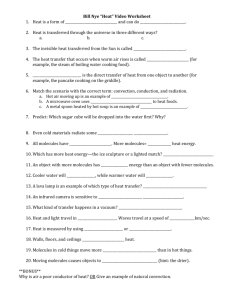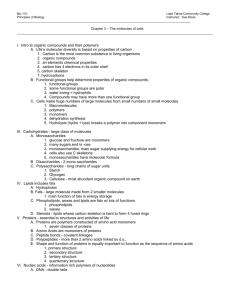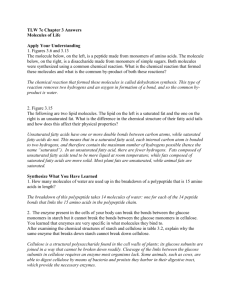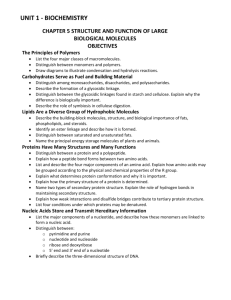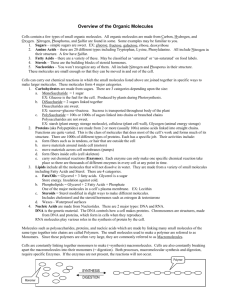Practice Free Response Question, Biochemistry
advertisement
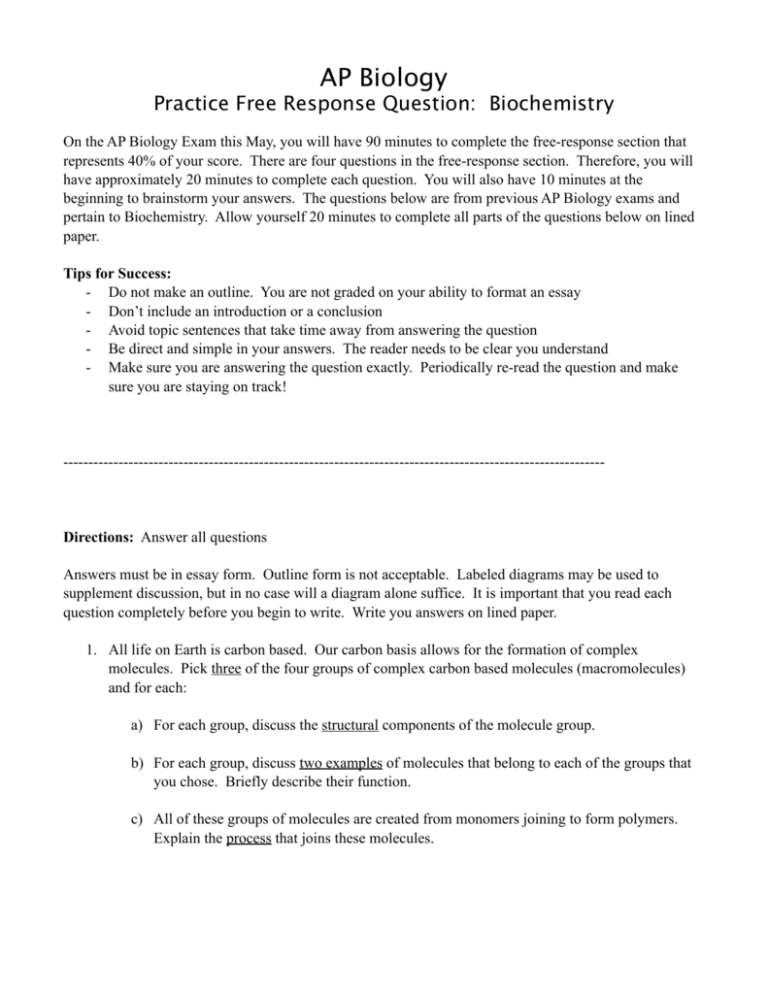
AP Biology Practice Free Response Question: Biochemistry On the AP Biology Exam this May, you will have 90 minutes to complete the free-response section that represents 40% of your score. There are four questions in the free-response section. Therefore, you will have approximately 20 minutes to complete each question. You will also have 10 minutes at the beginning to brainstorm your answers. The questions below are from previous AP Biology exams and pertain to Biochemistry. Allow yourself 20 minutes to complete all parts of the questions below on lined paper. Tips for Success: - Do not make an outline. You are not graded on your ability to format an essay - Don’t include an introduction or a conclusion - Avoid topic sentences that take time away from answering the question - Be direct and simple in your answers. The reader needs to be clear you understand - Make sure you are answering the question exactly. Periodically re-read the question and make sure you are staying on track! ------------------------------------------------------------------------------------------------------------ Directions: Answer all questions Answers must be in essay form. Outline form is not acceptable. Labeled diagrams may be used to supplement discussion, but in no case will a diagram alone suffice. It is important that you read each question completely before you begin to write. Write you answers on lined paper. 1. All life on Earth is carbon based. Our carbon basis allows for the formation of complex molecules. Pick three of the four groups of complex carbon based molecules (macromolecules) and for each: a) For each group, discuss the structural components of the molecule group. b) For each group, discuss two examples of molecules that belong to each of the groups that you chose. Briefly describe their function. c) All of these groups of molecules are created from monomers joining to form polymers. Explain the process that joins these molecules. Practice Free Response Question: Biochemistry All life on Earth is carbon based. Our carbon basis allows for the formation of complex molecules. Pick three of the four groups of complex carbon based molecules (macromolecules) and for each: discuss the structural components of the molecule group, discuss two examples of molecules that belong to each of the groups that you chose and briefly describe their function and finally, explain the process that joins these molecules in polymers. GRADING RUBRIC (NOTE: Points can only be received on three of the macromolecule groups. If all four have been described, grade the first three named) PART A: For each group, discuss the structural components of the molecule group. 8 points possible Carbohydrates: 1 point for each of the following (2 points maximum) Polymers are built of chains of monosaccharides joined by glycosidic linkages Have the molecular formula (CH2O)n Hydroxyl group is attached to each carbon One carbon contains a carbonyl group In aqueous solutions many monosaccharides form rings Lipids: 1 point for the following (1 point maximum) Consist mostly of hydrocarbons Tryglycerides consist of a single glycerol and three fatty acids 1 point for the following (1 point maximum) Glycerol is an alcohol with three carbons Fatty Acids are long hydrocarbon chains with a carboxyl group at one end Unsaturated fatty acid chains contain one or more double bonds between carbons causing “kinks” in the chain, while saturated fatty acid chains do not contain double bonds. Phospholipids consist of glycerol, 2 fatty acids, and a phosphate group. Steroids consist of four carbon rings with no fatty acid tails Proteins: 1 point for the following (1 point maximum) Chains of amino acid monomers connected by peptide bonds Have a 3-dimensional globular shape 1 point for the following (1 point maximum) Amino acids are molecules that consist of a carboxyl group, an amino group and an R-group Interactions created by R-groups on different amino acids results in the unique folding of an individual polypeptide Nucleic Acids: 1 point for the following (1 point maximum) Consist of Nucleotide Monomers Nucleotides are made up of a 5-carbon sugar, a phosphate group, and a nitrogenous base 1 point for the following (1 point maximum) Backbone created by phosphate groups of one nucleotide forming strong covalent bonds with the sugar of the next nucleotide In RNA, a singe helix structure is formed In DNA, nitrogenous bases base pair to form a double helix structure PART B: For each group, discuss two examples of molecules that belong to each of the groups that you chose. Briefly describe their function. 7 points possible Carbohydrates: 1 point for each of the following (2 points maximum) Any monosaccharide (e.g. glucose, fructose, galactose, ribose, etc.): major energy source in living things Starch: plant storage form of energy Cellulose: fiber-like structural material used in plant cell walls Glycogen: animal short-term storage form of energy Chitin: structural material (arthropod exoskeleton and fungal cell walls) Lipids: 1 point for each of the following (2 points maximum) Tryglycerides: energy storage, insulation, shock absorption Phospholipids: Main structural component of membranes, where they arrange in bilayers. Waxes: Lipids that serve as coatings for plant parts and as animal coverings. Steroids: Component of animal cell membranes and/or modified to form sex hormones Proteins: 1 point for each of the following (2 points maximum) Enzymes: speed up chemical reactions Antibodies: part of the immune system, which locate invading cells/substances in the body Any other example of a protein with function listed; such as Hemoglobin: an oxygen-transport protein in red blood cells Nucleic Acids: 1 point for each of the following DNA: contains the genetic code for proteins passed from one generation to another RNA: functions in actual synthesis of proteins coded for by DNA PART C: All of these groups of molecules are created from monomers joining to form polymers. Explain the process that joins these molecules. 2 points possible 1 point for each of the following: Condensation reaction called dehydration synthesis Monomers are linked together by covalent bonds and water is lost from the two joining molecules. 17 total points (scored out of a 10)



